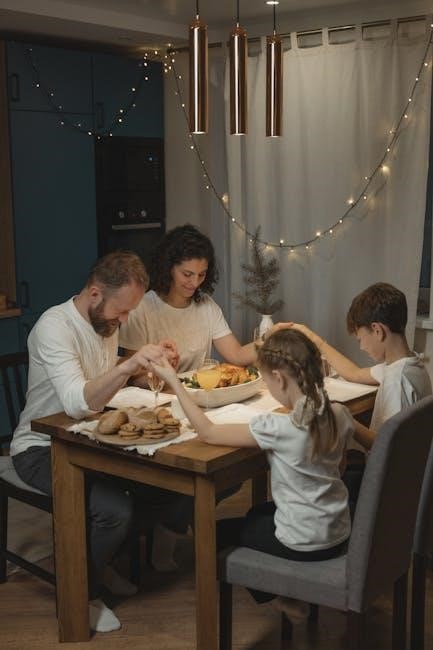
gratitude worksheet pdf
What is a Gratitude Worksheet?
A gratitude worksheet is a structured tool designed to cultivate thankfulness․ It often includes prompts, space for writing or drawing, and focuses on specificity․ These worksheets promote mindfulness and encourage reflection on positive aspects of life․

Benefits of Using Gratitude Worksheets
Gratitude worksheets enhance mental well-being by fostering positive emotions․ They strengthen relationships through increased appreciation and boost overall happiness․ Regularly using these worksheets promotes a more thankful outlook on life․
Improved Mental Well-being
Practicing gratitude through worksheets can significantly improve mental well-being․ Regularly focusing on positive aspects reduces stress and anxiety․ Gratitude promotes optimism, fostering a more resilient mindset․ It shifts attention away from negative thoughts and feelings, enhancing overall emotional health․ Engaging with gratitude worksheets encourages mindfulness and appreciation, leading to increased happiness and contentment․ This practice can be a valuable tool for managing daily stressors and cultivating a positive outlook․
Strengthened Relationships
Expressing gratitude, facilitated by worksheets, strengthens relationships by fostering appreciation and connection․ Recognizing and acknowledging others’ contributions enhances feelings of closeness and understanding․ Gratitude promotes empathy and compassion, improving interpersonal interactions․ Sharing gratitude with loved ones creates a positive feedback loop, reinforcing bonds․ Utilizing worksheets to reflect on positive qualities in others encourages a more appreciative perspective, leading to healthier and more fulfilling relationships․ Regular practice of expressing thankfulness cultivates stronger, more meaningful connections with those around you․
Increased Happiness
Gratitude worksheets contribute to increased happiness by shifting focus from negativity to positivity․ Regularly acknowledging blessings fosters a sense of contentment and joy․ By intentionally reflecting on positive aspects of life, individuals experience heightened emotional well-being․ Gratitude promotes optimism, resilience, and a more positive outlook․ Worksheets provide a structured method to cultivate thankfulness, leading to sustained happiness․ Focusing on what you have, rather than what you lack, breeds satisfaction and reduces feelings of envy․ Consistent gratitude practice transforms perspective and enhances overall happiness levels․
Key Components of an Effective Gratitude Worksheet
Effective gratitude worksheets include prompts for reflection, dedicated space for writing or drawing, and a focus on specificity․ These components guide users to thoughtfully acknowledge and appreciate the positive aspects of their lives․
Prompts for Reflection
Effective gratitude worksheets use prompts that encourage reflection, guiding users to delve deeper into their experiences․ These prompts stimulate thoughtful consideration of specific aspects of life, fostering a greater sense of thankfulness․ They might ask about acts of kindness received, small joys experienced, or positive qualities in oneself and others․ These prompts help focus attention on identifying the good and expressing appreciation for it, making gratitude practices more impactful․
Space for Writing or Drawing
A crucial element of a gratitude worksheet is dedicated space for users to express their thoughts․ This section provides an area for writing detailed entries about what they are grateful for, or alternatively, allows them to visually represent their feelings through drawing․ The flexibility to choose between writing and drawing caters to different preferences and creative styles, making the worksheet accessible and engaging for diverse users, encouraging deeper reflection․
A Focus on Specificity
Effective gratitude worksheets emphasize specificity․ Instead of general statements like “I’m grateful for my family,” prompts encourage users to identify particular instances or qualities they appreciate․ For example, “I’m grateful my mom made me soup when I was sick․” This detail enhances the emotional impact, making the practice more meaningful․ Specificity fosters deeper reflection, prompting users to acknowledge nuances and details that might otherwise go unnoticed․ It leads to a more profound sense of gratitude․
Types of Gratitude Worksheets Available
Gratitude worksheets come in various forms․ These include daily gratitude journals, gratitude lists, and specialized prompts for children․ Each type caters to different preferences and age groups, fostering thankfulness in diverse ways․
Daily Gratitude Journals
Daily gratitude journals are structured worksheets designed for regular reflection on positive aspects of life․ These journals typically offer prompts to guide entries, encouraging users to identify specific things they are thankful for each day․ Consistent use fosters a habit of thankfulness, enhancing overall well-being․ Many formats exist, from simple lists to more detailed reflective writing prompts․ They are available as printable PDFs․
Gratitude Lists
Gratitude lists are a simple and effective type of gratitude worksheet․ They involve creating a straightforward list of things one is thankful for․ This format encourages quick reflection and can be easily incorporated into a daily routine․ Available as printable PDFs, gratitude lists offer a convenient way to cultivate thankfulness․ They’re especially helpful for those new to gratitude practices or seeking a time-efficient method․
Gratitude Prompts for Kids
Gratitude prompts for kids are specialized worksheets designed to encourage children to recognize and appreciate the good things in their lives․ These often include playful designs and easy-to-understand questions․ Printable PDFs make these worksheets accessible for parents and educators․ Prompts may focus on family, friends, nature, or personal experiences, helping children develop a habit of thankfulness from a young age, fostering positivity and well-being․

Free Printable Gratitude Worksheets
Discover free gratitude worksheets online designed to cultivate daily thankfulness․ These resources enhance personal growth with practical, easy-to-use formats․ Many options are available in PDF format, offering accessible tools for developing a gratitude habit․
Where to Find Them Online
Numerous websites offer free, printable gratitude worksheets․ Educational platforms like Teachers Pay Teachers often provide resources created by educators․ Websites focused on mindfulness and personal development frequently host downloadable worksheets․ Search terms like “free gratitude worksheet PDF” will yield many results․ Many blogs focused on family activities and parenting also offer these resources as free downloads․ Always check the source’s credibility to ensure the worksheet aligns with your goals and values before downloading and using it․
Examples of Different Worksheet Styles
Gratitude worksheets come in various styles, from daily journals with open-ended prompts to structured lists focusing on specific areas of life․ Some feature coloring pages or drawing prompts, particularly for children․ Others provide questionnaires to measure gratitude levels․ Worksheets can be designed for individual reflection or as activities for families․ Some focus on identifying things you are grateful for, while others prompt deeper reflection on why you are thankful for them․ Choose a style that best suits your needs and preferences․
How to Use a Gratitude Worksheet Effectively
To effectively use a gratitude worksheet, set aside dedicated time, be specific in your entries, and review past entries․ Consistency is key․ Focus on the positive aspects and reflect on the reasons․
Setting Aside Dedicated Time
To truly benefit from a gratitude worksheet, carving out dedicated time is essential․ Integrate it into your daily routine, perhaps as a morning ritual or before bedtime․ Consistency allows for deeper reflection․ Choose a quiet space, free from distractions, to focus․ This deliberate approach enhances mindfulness and maximizes the positive impact of expressing gratitude, fostering a more thankful outlook on life and boosting overall well-being․
Being Specific in Your Entries
When using a gratitude worksheet, avoid generic statements․ Instead, focus on the details․ Instead of writing “I’m grateful for my family,” specify a particular act of kindness or a shared memory․ Specificity amplifies the emotional impact and makes the practice more meaningful․ Detailing the ‘what,’ ‘why,’ and ‘how’ of your gratitude reinforces positive feelings․ This deeper engagement cultivates a more profound sense of appreciation and boosts the benefits of the exercise․
Reviewing Past Entries
Periodically revisit your completed gratitude worksheets․ Rereading past entries serves as a powerful reminder of the positive aspects of your life, especially during challenging times; This practice can reignite feelings of thankfulness and provide a renewed sense of perspective․ Noticing patterns in your gratitude can also reveal what truly matters to you․ The act of reviewing reinforces the benefits of gratitude and promotes sustained well-being, fostering joy and contentment․

Gratitude Worksheets for Kids: Activities and Ideas
Engage children with fun gratitude activities using worksheets! Ideas include coloring pages, gratitude jars, and “Things I am Grateful For” sheets․ These activities foster thankfulness and positive thinking in a playful, accessible way․
Coloring Pages with Gratitude Themes
Coloring pages offer a creative way for children to express gratitude․ These pages often feature images related to things kids are thankful for, such as family, friends, nature, or favorite toys․ Combining coloring with gratitude themes encourages mindfulness and positive associations․ Many free printable options are available online, providing playful designs suitable for various age groups․ These activities seamlessly blend artistic expression with cultivating an attitude of thankfulness․
Gratitude Jar Activities (Worksheet Version)
A worksheet version of the gratitude jar activity provides a structured way for children to list things they are thankful for․ Instead of physically placing notes in a jar, kids write or draw their gratitudes on the worksheet․ These worksheets often feature a visual representation of a jar, which children fill with words and pictures․ This activity promotes thankfulness and offers a tangible record of positive thoughts․ Printable versions are readily available․
“Things I am Grateful For” Worksheets
“Things I am Grateful For” worksheets are designed to help children develop an attitude of gratitude․ These worksheets encourage children to list specific things they appreciate in their lives․ Often used in lessons about thankfulness, they act as a coping tool intervention for kids․ The practice of gratitude promotes calming and grounding․ Worksheets are often designed with playful, engaging graphics to appeal to young children, making the activity both educational and enjoyable․
Gratitude Questionnaires: Measuring Gratitude Levels
Gratitude questionnaires assess an individual’s level of thankfulness․ These tools employ questions to gauge appreciation․ The GQ-6, a brief six-item questionnaire, provides an impression of a person’s innate gratefulness in under 30 seconds․
The Gratitude Questionnaire-Six Item Form (GQ-6)
The Gratitude Questionnaire-Six Item Form (GQ-6) is a concise tool designed to quickly assess an individual’s disposition towards gratitude․ Created by Michael E․ McCullough, Robert A․ Emmons, and Jo-Ann Tsang, this questionnaire consists of six questions․ Responses to these questions offer insights into how grateful a person generally is; Completing the GQ-6 typically requires minimal time, often less than 30 seconds, making it a practical option for quick evaluations of gratitude levels․
How to Interpret the Results
Interpreting the results of a gratitude questionnaire like the GQ-6 involves understanding the scoring system․ Higher scores generally indicate a stronger disposition toward gratitude, reflecting a greater tendency to appreciate and acknowledge positive aspects of life․ Conversely, lower scores may suggest a lesser inclination towards gratitude․ These results can be used to identify areas where individuals might benefit from cultivating more thankfulness through practices such as journaling or specific gratitude exercises, providing a basis for personal growth and well-being․

Integrating Gratitude Worksheets into Therapy
Gratitude worksheets can be valuable therapeutic tools․ They help clients focus on positive aspects, fostering emotional well-being․ These worksheets encourage reflection and can be easily integrated into therapy sessions for enhanced client outcomes․
Using Worksheets as a Therapeutic Tool
Gratitude worksheets offer a structured approach within therapy to cultivate thankfulness․ They guide clients in identifying and reflecting upon positive aspects of their lives, promoting a shift in perspective․ Therapists can use these worksheets to facilitate discussions about appreciation and resilience․ By providing a tangible medium for reflection, these tools support emotional processing and foster a more positive outlook․ The worksheets encourage clients to actively engage in recognizing blessings, ultimately enhancing their overall well-being and therapeutic outcomes․
Benefits for Clients
Clients using gratitude worksheets often experience improved mental well-being, including reduced stress and increased happiness․ These worksheets can strengthen relationships by fostering appreciation for others․ Clients may develop a more positive outlook, enhancing their resilience and coping skills․ By focusing on positive aspects, clients cultivate a sense of contentment and reduce negative thought patterns․ Gratitude practices encourage self-reflection and mindfulness, promoting emotional regulation․ Ultimately, these worksheets empower clients to actively engage in recognizing blessings, fostering a more fulfilling and grateful life․